
Before we begin, let us first understand what metaverse is. And no, it is not a verse controlled by Meta (previously known as Facebook). There is no universally accepted definition for the term “metaverse”. In simple words, it is used to refer to an as-yet-undeveloped future of the internet. Metaverse refers to the bridge between our physical reality and the multiuser virtually. It includes everything from virtual objects to digital people. This bridge generally includes the use of virtual reality, augmented reality and avatars among others. I guess most of us have made our Avatar in some social media application without knowing that we are actually forming an instrument to potentially link ourselves to the Metaverse? Since multiple people can use it at once, it creates an immersive reality for people making them believe they are a part of it. As the word suggests, people can perform all activities in this world which makes metaverse of the same social value as the real world.
The interest shown from the world’s largest tech companies makes us inclined towards the huge potential that the metaverse has and all the unknown legalities that it brings along with it. This new era brings a maze of potential problems for IP owners ranging from copyrights to trademarks and maybe even hybrid issues. Technology is always ahead of litigation and delays in legal advancement will perpetuate inconsistent decisions. The activities that take place in the metaverse are said to be decentralized meaning they are not controlled by a single authority itself and there is a high chance that territorial and jurisdictional issues may loom large. Transactions in the metaverse will attract lawsuits as they involve real money, and therefore our laws have to be moulded to fulfil the growing needs of technology.
The metaverse is not only a new and growing platform for the creation of copyrighted work but also a space for the infringement of other people’s rights. Intellectual Property infringement acts in the metaverse occurs when a person uses in that verse, without due authorization, creations which they do not own in the real world. Among different types of tokens, non-fungible tokens (NFTs) have been the centre of most litigation in the metaverse. NFT is a token that consists of a unique digital representation of a specific digital element that is stored using blockchain technology and can be transferred and, therefore, traded. These are collectibles that would be for example art or property in the real world. They’re designed in a way in which they cannot be duplicated on a blockchain.
The concept of NFTs has raised many questions related to intellectual property rights. Some of which: who can own the intellectual property rights of an NFT, can NFTs be minted on the basis of copyrighted works or renditions, what happens if the NFT infringes a real-life work? These are a few of the many questions that the conception of the metaverse has brought upon.
In January 2022, French luxury brand Hermès sued a digital artist, Mason Rothschild, for copying its Birkin handbag through the issuance of MetaBirkin non-fungible tokens (NFTs), after Rothschild created fuzzy images of the Hermès Birkin handbag and minted them as NFTs.
Nike also sued StockX for selling NFTs of images of Nike sneakers without the company’s permission, arguing they infringed its trademarks by causing consumer confusion. These two high-profile cases have kept us on tenterhooks.
As we move towards the metaverse, the main question that arises is: Will our intellectual property laws be able to withstand the onslaught of technology? Are the laws of Nepal are fit to address such possible litigations? Metaverse is advancing rapidly and as with any groundbreaking technological development, the metaverse will raise novel and complex legal issues. NFTs are still an alien concept in Nepal, however, this does not guarantee that it always will be. Unlike other developed countries’ robust IP laws, Nepal’s almost 60-year-old Patents Designs and Trademarks Act and 20-year-old Copyright Act are not mighty enough to survive this challenge and potential issues that lie ahead of us. With the IP Bill and Copyright Act Amendment right in the corner, our lawmakers must apply these new fact patterns that have been raised and fill out the framework of our laws with those technological advancements in mind.
READ ALSO:
Published Date: September 30, 2022, 12:00 am
Post Comment
E-Magazine
RELATED Guest Column


.jpg)


